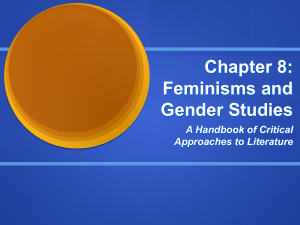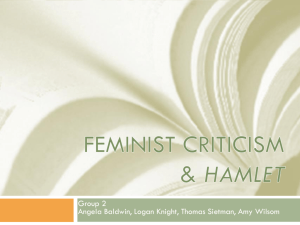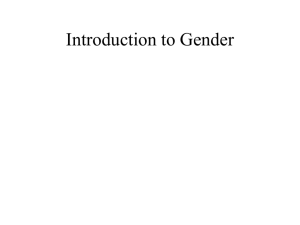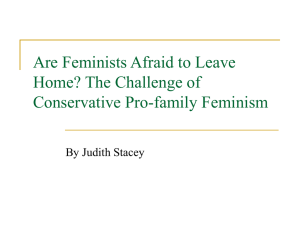Feminisms and Gender Studies
advertisement
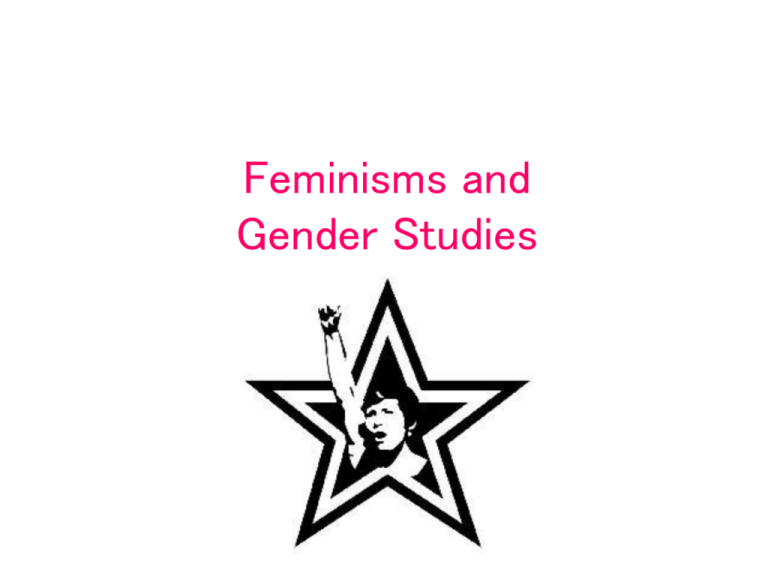
Feminisms and Gender Studies Feminisms engage with biological, linguistic, psychoanalytic, Marxist, poststructuralist, and cultural studies as well as ethnic and race studies, postcolonial theory, lesbian and gay studies and gender studies. Focus upon what is absent rather than what is present, reflecting concern with the silencing and marginalization of women in a practical culture, a culture organized in the favor of men. "I myself have never been able to find out precisely what feminism is; I only know that people call me a feminist whenever I express sentiments that differentiate me from ... a doormat ..."--Rebecca West, 1913 Kate Millet is an American feminist writer and activist. She is best known for her 1970 book Sexual Politics. In her book, The Second Sex(1949), Simone de Beauvoir asked what is woman, and how is she constructed differently from men? Answer: she is constructed differently by men. "The Feminine Mystique," first published in 1963. Friedan "pulled the trigger on history," wrote futurist Alvin Toffler; feminist admirers refer to it as "The Book." Friedan, who died in 2006, answered that question: No, it is not all. "What happened to [women's] dreams?" she asked. What happened to their "share in the whole of human destiny?" What happened, according to Friedan, is that women's magazines, advertisers, and an army of Freudian social scientists conspired to persuade American women that the fulfillment of their femininity was their truest and highest calling. Elaine Showalter has identified three phases of modern women’s literary development: the feminine phase (1840-80), during which women writers imitated the dominant male traditions; Elaine Showalter The second one is the feminist phase (18801920), when women advocated for their rights; and the female phase(1920-present) emphasizes on the rediscovery of women’s texts and women Today it seems that two general tendencies, one emphasizing Showalter’s biological, linguistic, and psychoanalytic models, and the other emphasizing cultural model, account for most feminist theories. Certain theories may be said to have an essentialist argument for inherent feminine traits that have been undervalued, misunderstood, or exploited by a patriarchal culture because the genders are quite different. Barbara Kruger: your-body-is-a-battleground-1989 These theories focus on sexual difference and sexual politics and are often aimed at defining or establishing a feminist literature (and culture, history and so forth) from a less patriarchal slant. Opposed to this notion is constructivist feminism, which asks women (and men) to consider what it means to be a woman, to consider that inherently female traits are in fact culturally and socially constructed. The famous type of monster-madwoman figure is the madwoman in the attic in Charlotte Bronte’s novel Jane Eyre. Many essentialist feminists make the argument that female writers often identify themselves with the literary characters they detest through such types as the monster/madwoman figure counterpoised against an angel/heroine figure. Like Freud, Jacques Lacan describes the unconscious as structured like a language; like language its power often arises from the sense of openness and play of meaning. Jacques Lacan comes to the notion of the Imaginary, a pre-Oedipal stage in which the child has not yet differentiated her- or himself from the mother and as a consequence has not learned language, which is the Symbolic Order to be taught by the father. Hélène Cixous proposes a utopia place, a primeval female space free of symbolic order, sex roles, otherness, and the Law of Father. The feminine “language” of the unconscious destabilizes sexual categories in the Symbolic Order of the Father, disrupting the unities of discourse and indicating its silencing. French feminists speak of “exploding” rather than interpreting a sign. Luce Irigaray etymologically links the word “matter” to “maternity” and “matrix,” the latter being the space for male philosophizing and thinking. Luce Irigaray. No mater how theoretical and abstract French feminists’ prose becomes, French feminists do not astay far from the body. Julia Kristeva’s latter work moves toward a more direct embrace of motherhood as the model for psychic female health. Julia Kristeva, in her Desire in Language, presents a mother-centered realm of the semiotic as oppose to the symbolic. She argues that the semiotic realm of the mother is present in symbolic discourse as absence or contradiction. Among the most prominent of feminist minorities are women of color and lesbians. These feminists practice what is sometimes called identity politics. Black feminists have often turned to the slave narrative and the captivity narrative, both old American forms of discourse, as of especial importance to black women writers. Bell Hooks is a famous critic who challenges the traditional canon. Chakravorty Gayatri Spivak Related to the rise of feminisms among women of color is the area of postcolonial studies. Chakravorty Gayatri Spivak examines the effects of political independence upon subaltern , or subproletarian women, in Third World countries. The significant source of constructivist feminism is Marxism, especially its focus upon the relations between reading and other social constructions. As Karl Marx argued that all historical and social developments are determined by the forms of economic production, Marxist feminists have attached the “classist” values of the prevailing capitalist society of the West as the world also gradually becomes “globalized.” Marxist feminists are attacked for misunderstanding the nature of quality in art. Yet Lillian Robinson pointed out that Feminist criticism must be “ideological and moral criticism, it must be revolutionary”(3). Teresa de Lauretis and Laura Mulvey Laura Mulvey’s insight in the “male gaze” which she describes is based upon Voyeurism and fetishism, the only available pleasure (usually) being the male one of looking at women’s bodies for sexual cues. Ex. In films like Charlie’s Angels (2002) and Monster (2003), and Kill Bill (2003, 2004) As a constructivist endeavor, gender studies examines how gender is less determined by nature than it is by culture, and such a cultural analysis is at the center of the most complex and vital critical enterprises at the present time. Gender is a construct, “an effect of language, a culture, and its institutions.” Many theorists point out that what is “normal” sexually depends upon when and where one lives Lesbian critics counter their marginalization by considering lesbianism a privileged stance testifying to the primacy of women. Lesbian critics reject the notion of a unified text, finding corroboration in poststructuralist and post modernist criticism and among the French feminists. In 1978 the first volume of Foucault’s History of Sexuality was translated. It argued that homosexuality is a social, medical, and ontological category invented in the late 19th century and then imposed on sexual practices that prior to that time discouraged and punished nonreproductive sexual alternatives. Queer theory as such postmodern concepts as gender ambivalence, ambiguity, anf multiplicity of identities have replaced the more clearly defined sexual values of earlier generations. “Queer” rejects the conventions of Western sexual more with a commitment only to pleasure. Increasingly in the last few years, gay characters, themes, and programs now appear on all major TV channels and are the subjects of Hollywood films. When Night is Falling -the exotic can be problematic it is still cinematically beautiful and the love story at its center is enthralling. Better than Chocolate – art, bookstores, first love, and musical numbers, with a wide range of lesbian identities and an equally centered trans woman, can you ask for anything more? What is most arresting about the address is its shocking attack upon female body. The speaker seeks to frighten her into sexual compliance when his fancy philosophy does not seem persuasive enough. His use of such force is clearest in his violent and grotesque description of her body. The word vault(a tomb) points toward her death. The connection with penetrating worms from the lines before is in the wish to ignite her very soul. Attack upon the woman as fortress and the use of fire to suggest arousal were common tropes in 16th century love sonnets. The lady of the poem is subject to being torn, opened up , or devoured by her admirer. The feminine is portrayed here as a negative state: she does not assent: she is not in the poem. It is a poem about power, and the power lies with the silent female, with the vault or womb- the negative space of the feminine. No mention is made of procreation in the poem, nor marriage, nor even love. It is about sex. He is also satirizing himself in his outrageous imagistic attempts to scare her into sex with him. Hamlet contends with woman’s body, his mother’s and he finds its sexual proclivities disgusting, as he rails at her in her chamber. He loathes himself for being born out of the female body. The emphasis upon family relationships and specifically the politics of sex from the beginning of the play is accompanied by the emphasis upon political matters of the realm at large. It is about the politics of masculinity and femininity. The father-son images in Claudius’s description of matters between Denmark and Norway are followed by Claudius’s fatherly behavior to young Laertes and then by the first appearance of Hamlet. • Hamlet’s mediation upon his mother’s faults and his later assalt upon her are keys to understanding his torment, but while many critics have been content to move through the play seeing Gertrude only through her son’s angry eyes. • Hamlet Project upon Gertrude with these evident dimensions of her character since Gertrude’s body is the literal and symbolic ground of all conflicts in the play; her body and soul are contested by her son, husband and countries. "The Play Scene in Hamlet" by Daniel Maclise ( 1842) Ophelia, Hamlet, and the court watching the "mousetrap" play-within-a-play. 1851年Millais, Ophelia Adolph-William Bouquereau, La Petite Ophélie (TheYoung Ophelia) Calling Hamlet a “rose” feminizes him to some degree. The metaphor perhaps points out toward his denial of unconscious drives and aspects, and her speech emphasizes his “feminine” traits of gentleness, a forgiving heart, stability, caught as he is in the throes of his gendered ego struggle. Kate Ellis finds that Frankenstein critiques “a bifurcated social order” that separates “the masculine sphere of discovery and the feminine sphere of domesticity.” Victor’s sin of expropriating the function of the female by giving “birth” to a child would seem to be a bridging of the two spheres. 1. Mary ad Percy, author and editor: Death and birth were “hideously mixed” in the life of Mary Shelly, notes Ellen Moers, just as they were in Victor’s workshop of filthy creation. 2. Masculinity and femininity in the Frankenstein family: “masculine persuasion”- the teller in each case is speaking into a mirror of his own transgression. 3. I am thy creature…: Victor’s abandonment of his creation than for his hubris in having first created him. Like Elizabeth’s, the monsterette’s creation and destruction dramatize how women function not in their own right but rather as signs of and conduits for men’s relations with other men, simply counters in the struggle between Victor and the monster in himself. Nathaniel Hawthorne’s portraits of women go against the literary conventions of his day. Hawthorne treated women with more realism and depth than did most other male writers, paving the way for the development of realism and naturalism at the close of the century in the works of Henry James, William Dean Howells, Edith Wharton and Theodore Dreiser; all of these writers portray women as powerful moral against rather than one-dimensional moral objects. The story centers specifically on Faith Brown’s husband’s rejection of her; the tale may be read as a psychosexual parable of the rejection of the feminine in favor of a fatherfigure symbolized by the Devil. The sexuality inherent in Goodman Brown’s forest meeting is reinforced by the repeated mention of the women who will be there, from Goody Cloyse and the governor's wife to the most spent of prostitute. Its quilt is an emblem of American women’s culture, as it is an object of communal construction and female harmony. In “Everyday Use” Walker poses problems of heritage in response to the black power movements of the 1960s in which she grew up, especially the kind of cultural nationalism that demanded imitation of features of the American past. “Everyday Use” contains women of all three cycles of history. Maggie does not know her worth. Dee inhabits the second cycle: though she seems to reject white society, she fails to appreciates her own heritage until it becomes fashionable to do so. The mother prefigures the women of Walker’s third cycle in her self-reliance and firm sense of connectedness to her past. Walker has made a conscious choice in the story to use only women; all the men are dead, absent, unnamed. Maggie’s quiet femininity is upheld in the end when her mother takes her side. Dee has accepted the things but not the spirit of heritage Their mother is the bridge that connects past and future. Many ongoing issues generated in the various feminisms and gender studies are yet to be solved. The reductiveness of some feminist theory indicates the radical’s dislike of compromise. Surely somewhere other than in “political correctness” We read of a backlash against feminism, particularly on the political right. But surely the self-consciousness about gender roles generated by feminism from its earliest days will continue to inspire new adaptations by women and men entering the new millennium of literary investigation in feminisms, gender studies and elsewhere. Beauvior, de Simone. The Second Sex. 1949. Reprint. Harmondsworth, England: Penguin, 1972. Butler, Judith. The Judith Butler Reader. Ed, Judith Butler and Sarah Salih. London: Blackwell, 2004. Cixous, Hélène. “The Laugh of the Medusa.” Sign 1, no. 4 (1976): 875-93. Hooks, Bell. Ain’t I a Woman: Black Women and Feminism. Boston: South End P, 1981. Humm, Maggie. Feminist Criticism: Women as Contemporary Critics. Brighton, England: Harvester, 1986. Irigaray, Luce. Speculum of the Other Woman. Trans. Gillian C. Gill. Ithaca, NY: Cornell UP, 1985. Kristeva, Julia. Desire in Language. New York: Columbia UP, 1986.
